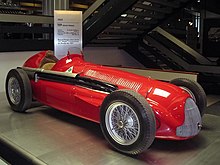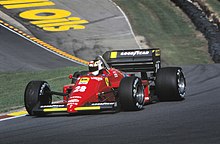Formula One theme by Louxx
Download: FormulaOne.p3t

(3 backgrounds)
 Formula One logo since 2018 | |
| Category | Open-wheel single-seater Formula auto racing |
|---|---|
| Country | International |
| Inaugural season | 1950 |
| Drivers | 20 |
| Teams | 10 |
| Chassis manufacturers | 10 |
| Engine manufacturers | |
| Tyre suppliers | Pirelli |
| Drivers' champion | (Red Bull Racing-Honda RBPT) |
| Constructors' champion | |
| Official website | www |
| Formula One |
|---|
Formula One, commonly known as Formula 1 or F1, is the highest class of international racing for open-wheel single-seater formula racing cars sanctioned by the Fédération Internationale de l'Automobile (FIA). The FIA Formula One World Championship has been one of the world's premier forms of racing since its inaugural running in 1950. The word formula in the name refers to the set of rules all participants' cars must follow. A Formula One season consists of a series of races, known as Grands Prix. Grands Prix take place in multiple countries and continents on either purpose-built circuits or closed public roads.
A point-system is used at Grands Prix to determine two annual World Championships: one for the drivers, and one for the constructors (the teams). Each driver must hold a valid Super Licence, the highest class of racing licence the FIA issues, and the races must be held on grade one tracks, the highest grade rating the FIA issues for tracks.
Formula One cars are the world's fastest regulated road-course racing cars, owing to very high cornering speeds achieved by generating large amounts of aerodynamic downforce. Much of this downforce is generated by front and rear wings, which have the side effect of causing severe turbulence behind each car. The turbulence reduces the downforce the cars following directly behind generate, making it hard to overtake. Major changes made to the cars for the 2022 season have resulted in greater use of ground effect aerodynamics and modified wings to reduce the turbulence behind the cars, with the goal of making overtaking easier.[1] The cars depend on electronics, aerodynamics, suspension, and tyres. Traction control, launch control, and automatic shifting, and other electronic driving aids were first banned in 1994. They were briefly reintroduced in 2001, and have more recently been banned since 2004 and 2008, respectively.[2]
With the average annual cost of running a team—designing, building, and maintaining cars, pay, transport—at approximately £220,000,000 (or $265,000,000),[3] Formula One's financial and political battles are widely reported. The Formula One Group is owned by Liberty Media, which acquired it in 2017 from private-equity firm CVC Capital Partners for £6.4 billion ($8 billion).[4][5]
History[edit]
Formula One originated from the World Manufacturers' Championship (1925–1930) and European Drivers' Championship (1931–1939). The formula is a set of rules that all participants' cars must follow. Formula One was a formula agreed upon in 1946 to officially become effective in 1947. The first Grand Prix in accordance with the new regulations was the 1946 Turin Grand Prix, anticipating the formula's official start.[citation needed] Before World War II, a number of Grand Prix racing organisations made suggestions for a new championship to replace the European Championship, but due to the suspension of racing during the conflict, the new International Formula for cars did not become formalised until 1946, to become effective in 1947. The new World Championship was instituted to commence in 1950.[citation needed]
The first world championship race, the 1950 British Grand Prix, took place at Silverstone Circuit in the United Kingdom on 13 May 1950.[6] Giuseppe Farina, competing for Alfa Romeo, won the first Drivers' World Championship, narrowly defeating his teammate Juan Manuel Fangio. Fangio won the championship in 1951, 1954, 1955, 1956, and 1957.[7] This set the record for the most World Championships won by a single driver, a record that stood for 46 years until Michael Schumacher won his sixth championship in 2003.[7]

A Constructors' Championship was added in the 1958 season. Stirling Moss, despite being regarded as one of the greatest Formula One drivers in the 1950s and 1960s, never won the Formula One championship.[8] Between 1955 and 1961, Moss finished second in the championship four times and third the other three times.[9][10] Fangio won 24 of the 52 races he entered—still the record for the highest Formula One winning percentage by an individual driver.[11] National championships existed in South Africa and the UK in the 1960s and 1970s. Promoters held non-championship Formula One events for many years. Due to the increasing cost of competition, the last of these was held in 1983.[12]
This era featured teams managed by road-car manufacturers, such as Alfa Romeo, Ferrari, Mercedes-Benz and Maserati. The first seasons featured prewar cars like Alfa Romeo's 158, which were front-engined, with narrow tyres and 1.5-litre supercharged or 4.5-litre naturally aspirated engines. The 1952 and 1953 seasons were run to Formula Two regulations, for smaller, less powerful cars, due to concerns over the dearth of Formula One cars.[13][14] When a new Formula One formula for engines limited to 2.5 litres was reinstated for the 1954 world championship, Mercedes-Benz introduced its W196, which featured things never seen on Formula One cars before, such as desmodromic valves, fuel injection, and enclosed streamlined bodywork. Mercedes drivers won the championship for the next two years, before the team withdrew from all motorsport competitions due to the 1955 Le Mans disaster.[15]
Technological developments[edit]

The first major technological development in the sport was Bugatti's introduction of mid-engined cars. Jack Brabham, the world champion in 1959, 1960, and 1966, soon proved the mid-engine's superiority over all other engine positions. By 1961 all teams had switched to mid-engined cars. The Ferguson P99, a four-wheel drive design, was the last front-engined Formula One car to enter a world championship race. It entered the 1961 British Grand Prix, the only front-engined car to compete that year.[16]
During 1962, Lotus introduced a car with an aluminium-sheet monocoque chassis instead of the traditional space-frame design. This proved to be the greatest technological breakthrough since the introduction of mid-engined cars.
In 1968, sponsorship was introduced to the sport. Team Gunston became the first team to run cigarette sponsorship on its Brabham cars, which privately entered in orange, brown and gold colours of Gunston cigarettes in the 1968 South African Grand Prix on 1 January 1968.[17] Five months later, the first works team, Lotus, followed this example when it entered its cars painted in the red, gold, and white colours of the Imperial Tobacco's Gold Leaf livery at the 1968 Spanish Grand Prix.
Aerodynamic downforce slowly gained importance in car design with the appearance of aerofoils during the 1968 season. In the late 1970s, Lotus introduced ground-effect aerodynamics, previously used on Jim Hall's Chaparral 2J in 1970, that provided enormous downforce and greatly increased cornering speeds. The aerodynamic forces pressing the cars to the track were up to five times the car's weight. As a result, extremely stiff springs were needed to maintain a constant ride height, leaving the suspension virtually solid. This meant that the drivers depended entirely on the tyres for any small amount of cushioning of the car and driver from irregularities of the road surface.[18]
Big business[edit]
Beginning in the 1970s, Bernie Ecclestone rearranged the management of Formula One's commercial rights; he is widely credited with transforming the sport into the multibillion-dollar business it now is.[19][20] When Ecclestone bought the Brabham team during 1971, he gained a seat on the Formula One Constructors' Association, and in 1978, he became its president.[21] Previously, the circuit owners controlled the income of the teams and negotiated with each individually; Ecclestone persuaded the teams to "hunt as a pack" through FOCA.[20] He offered Formula One to circuit owners as a package they could take or leave. In return for the package, almost all that was required was to surrender trackside advertising.[19]
The formation of the Fédération Internationale du Sport Automobile (FISA) in 1979 set off the FISA–FOCA war, during which FISA and its president Jean-Marie Balestre argued repeatedly with FOCA over television revenues and technical regulations.[22] The Guardian said that Ecclestone and Max Mosley "used [FOCA] to wage a guerrilla war with a very long-term aim in view". FOCA threatened to establish a rival series and boycotted a Grand Prix, and FISA withdrew its sanction from races.[19] The result was the 1981 Concorde Agreement, which guaranteed technical stability, as teams were to be given reasonable notice of new regulations.[23] Although FISA asserted its right to the TV revenues, it gave FOCA the administration of those rights.[24]
FISA imposed a ban on ground-effect aerodynamics during 1983.[25] But by then, turbocharged engines, which Renault had pioneered in 1977, were producing over 520 kW (700 bhp) and were essential to be competitive. By 1986, a BMW turbocharged engine achieved a flash reading of 5.5 bar (80 psi) pressure, estimated[who?] to be over 970 kW (1,300 bhp) in qualifying for the Italian Grand Prix. The next year, power in race trim reached around 820 kW (1,100 bhp), with boost pressure limited to only 4.0 bar.[26] These cars were the most powerful open-wheel circuit racing cars ever. To reduce engine power output and thus speeds, the FIA limited fuel tank capacity in 1984, and boost pressures in 1988, before banning turbocharged engines completely in 1989.[27]
The development of electronic driver aids began in the 1980s. Lotus began to develop a system of active suspension, which first appeared during 1983 on the Lotus 92.[28] By 1987, this system had been perfected and was driven to victory by Ayrton Senna in the Monaco Grand Prix that year. In the early 1990s, other teams followed suit and semi-automatic gearboxes and traction control were a natural progression. The FIA, due to complaints that technology was determining races' outcomes more than driver skill, banned many such aids for the 1994 season. This resulted in cars that previously depended on electronic aids becoming very "twitchy" and difficult to drive. Observers felt the ban on driver aids was in name only, as they "proved difficult to police effectively".[29]
The teams signed a second Concorde Agreement in 1992 and a third in 1997.[30]

On the track, the McLaren and Williams teams dominated the 1980s and 1990s. Brabham was also competitive during the early 1980s, winning two Drivers' Championships with Nelson Piquet. Powered by Porsche, Honda, and Mercedes-Benz, McLaren won 16 championships (seven constructors' and nine drivers') in that period, while Williams used engines from Ford, Honda, and Renault to also win 16 titles (nine constructors' and seven drivers'). The rivalry between racers Ayrton Senna and Alain Prost became F1's central focus during 1988 and continued until Prost retired at the end of 1993. Senna died at the 1994 San Marino Grand Prix after crashing into a wall on the exit of the notorious curve Tamburello. The FIA worked to improve the sport's safety standards since that weekend, during which Roland Ratzenberger also died in an accident during Saturday qualifying. No driver died of injuries sustained on the track at the wheel of a Formula One car for 20 years until the 2014 Japanese Grand Prix, where Jules Bianchi collided with a recovery vehicle after aquaplaning off the circuit, dying nine months later from his injuries. Since 1994, three track marshals have died, one at the 2000 Italian Grand Prix,[31] one at the
